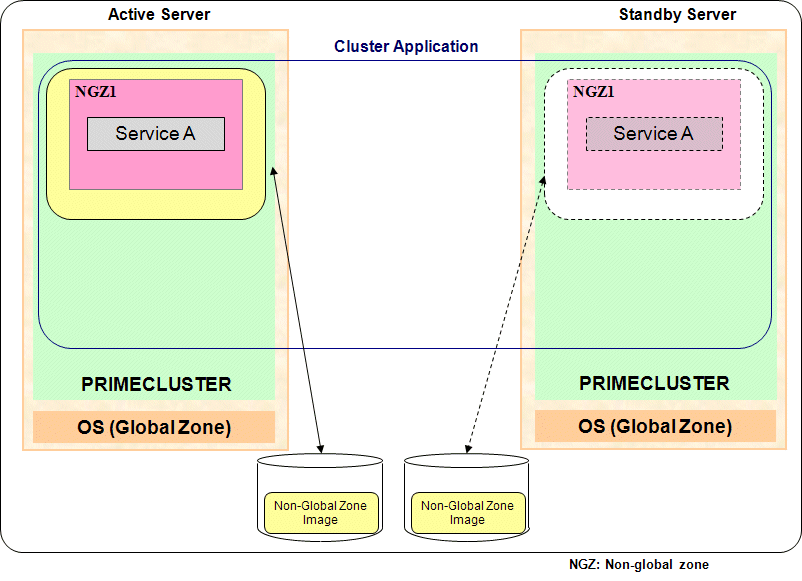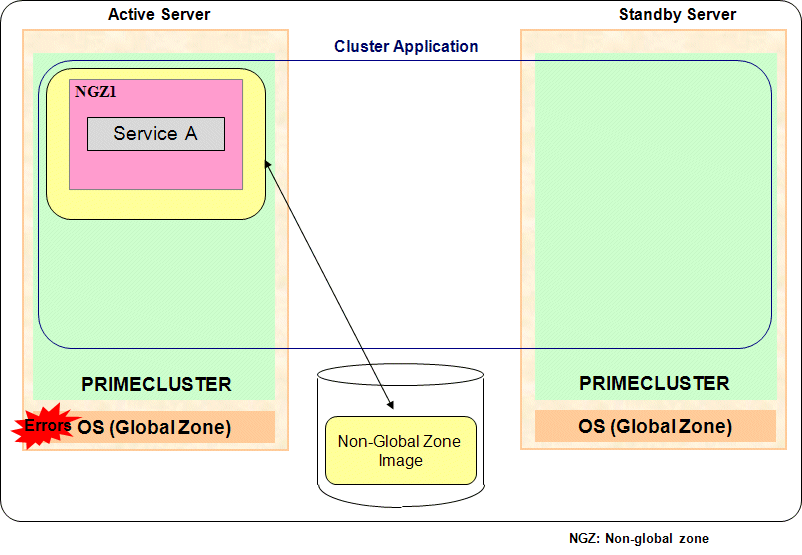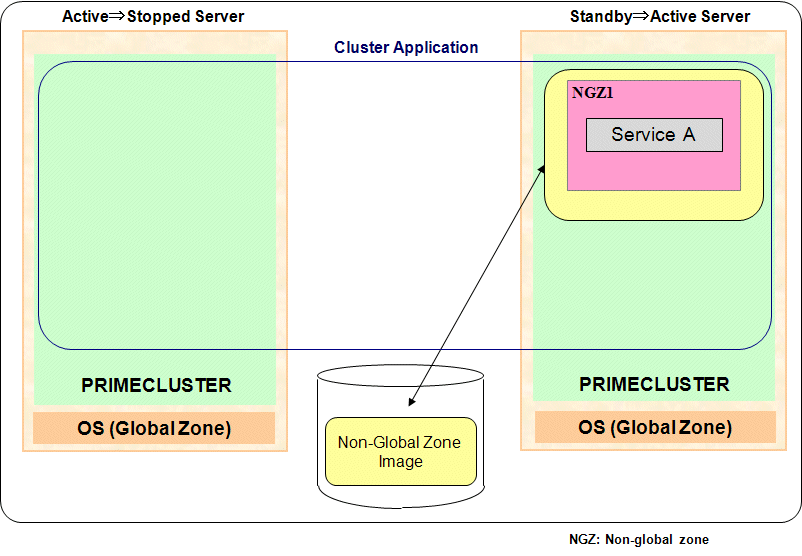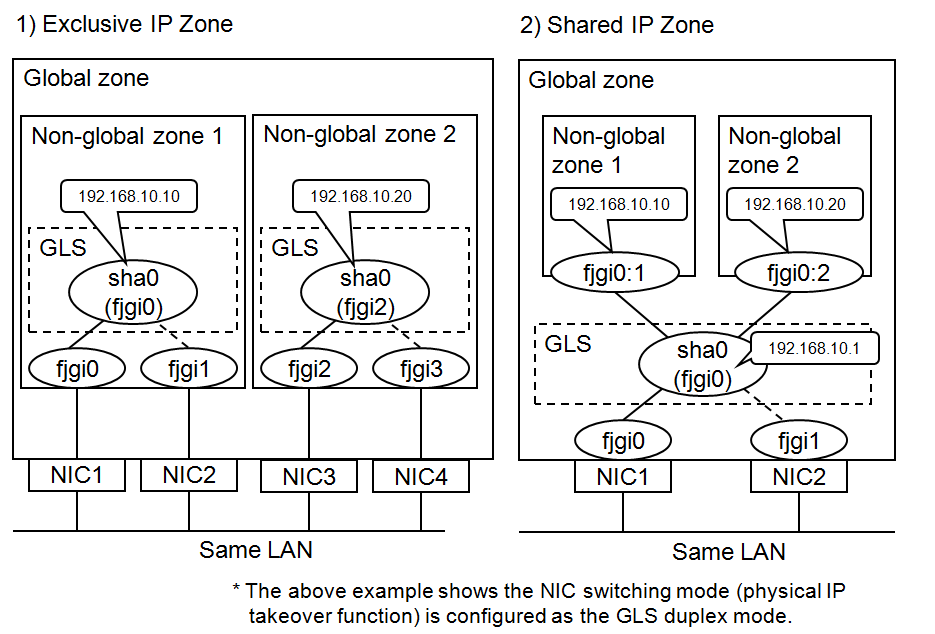If using PRIMECLUSTER with Oracle Solaris Zones environments, select the operation mode and configuration for each of the following items. For the criteria in selecting for each item, refer to the sections below.
Item | Choices |
|---|---|
Operation mode | Warm-standby operation Cold-standby operation Single-node cluster operation |
Non-global zone image allocation | Non-shared Shared |
Network mode | Exclusive IP zone Shared IP zone |
Application monitoring | Yes No |
The PRIMECLUSTER operations are on multiple nodes and on one node.
The features are as follows:
Item | Multiple nodes | One node |
|---|---|---|
Warm-standby operation Cold-standby operation | Single-node cluster operation | |
Operation recovery from soft errors | Available | Available |
Operation recovery from hard errors of the server | Available | Not available |
Enhancement of the availability by one node | Not available | Available |
When operating on multiple nodes, operation server enables the continuation of service by taking over the application running on the non-global zone to a standby server. There are two types of operations as follows:
Warm-standby Operation
With the non-global zones started up on both the operating server and standby server as is, this operation switches over only the applications operating within the non-global zone, and takes over services. Since the standby system's non-global zone OS enters a startup status, a faster switchover is possible.
Figure 13.1 Warm-standby Operation

Cold-Standby Operation
This operation takes over services between servers by starting the non-global zones on the standby server after the non-global zones on the operating server have been stopped. A configuration sharing non-global zone images between the cluster nodes is possible for this operation.
During operation, since this operation does not start non-global zones on the standby server, it does not use up CPU and memory resources.
Figure 13.2 Cold-Standby Operation


The characteristics for each operation mode are as follows.
Item | Warm-standby Operation | Cold-Standby Operation |
|---|---|---|
High-speed switchover | Available | Not available |
Conserving use of standby server CPU and memory | Not available | Available |
Non-global zone images not shared | Available | Available |
Non-global zone images shared | Not available | Available |
When operating on one node, the operation type is as follows:
Single-Node Cluster Operations
Monitor the status of the OS and applications on the non-global zones. The availability is increased by restarting the non-global zone or an application on the non-global zone automatically to perform recovery when an error is detected.
Figure 13.3 Single-Node Cluster Operations

It is possible to share non-global zone images between cluster nodes or, alternatively, allocate them to each node.
The characteristics for each configuration are as follows.
Item | Non-shared | Shared |
|---|---|---|
Warm-standby operation | Available | Not available |
Cold-standby operation | Available | Available |
Rolling update (maintenance of the standby system non-global zones while service operations are in progress) | Available | Not available |
Continuation of services through switchover when destruction of non-global zone images occurs | Available | Not available |
A shared disk for takeover of non-global zone images is not needed | Available | Not available |
Maintenance work is required only for one node | Not available | Available |
The non-global zones are identical in content for the operational system and standby system | Not available | Available |
Allocate non-global zone images to the following disk areas:
For Non-Shared
Allocate non-global zone images to volumes of the root class or local classes of GDS, or the disks which have not been registered with GDS.
For Shared
Allocate non-global zone images to the volume of GDS's shared class.
For the non-global zones' network mode, there are exclusive IP zone and shared IP zone.
Exclusive IP Zone
This is a network mode wherein the identified non-global zone has exclusive possession of the network interface. By splitting the global zone and non-global zone network interfaces, it is possible to split the network design between the zones.
Shared IP Zone
This is a network mode which shares with the non-global zone the network interface configured with the global zone. It is possible to share the network interface between a global zone and multiple non-global zones.
Figure 13.4 Network Mode and GLS Setup

The characteristics for each network mode are as follows.
Item | Exclusive IP Zone | Shared IP Zone |
|---|---|---|
Splitting the network design between zones | Available | Not available |
Sharing the network interface between a global zone and multiple non-global zones | Not available | Available |
Information
If performing non-global zone transmission with GLS fast switching mode or GS/SURE linkage mode, select the shared IP zone mode. Transmission which has used these modes is not possible with an exclusive IP zone. If using NIC switching mode, transmission is possible with either mode.
For Oracle Solaris Zones environments, PRIMECLUSTER, in addition to the global zone monitoring, also provides the following monitoring functions to the non-global zones.
Non-global zone status monitoring
PRIMECLUSTER confirms that the non-global zones have not stopped (this is confirmed with the status displayed using the zoneadm command)
Non-global zone OS error monitoring
Confirm that no error occurs when logging in (zlogin command) to non-global zone so that hang-ups in the non-global zones can be detected.
Additionally, if making the applications operating on the non-global zones the target for monitoring, the following type of monitoring is possible.
Non-global zone application monitoring
Provides an application monitoring function equivalent to monitoring on the global zone using the RMS operating on the non-global zones.
The characteristics of application monitoring are as follows.
Item | Application Monitoring | |
|---|---|---|
Yes | No | |
Detects stop to non-global zones | Available | Available |
Detects hang-ups with non-global zones | Available | Available |
Application monitoring for non-global zones | Available | Not available |
Note
To make applications operating on the non-global zones the target for monitoring, it is necessary to install PRIMECLUSTER to the non-global zones and create a single cluster configuration.
If performing application monitoring, for the resources which can be used in the non-global zone, refer to "13.1.3 Resource Configuration."
Be aware that the state of the non-global zone will not be detected as a resource fault when the abnormal state of the non-global zone does not continue for 10 seconds or more because the non-global zone is monitored at 10-second intervals by the Cmdline resource. For example, if the non-global zone is down abnormally but it is rebooted within 10 seconds, it will not be detected as a resource fault.